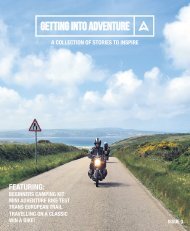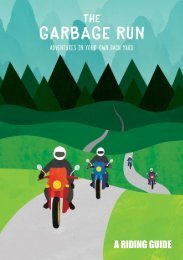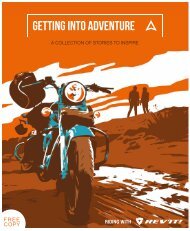Getting into Adventure Green
Create successful ePaper yourself
Turn your PDF publications into a flip-book with our unique Google optimized e-Paper software.
FILMING YOUR OWN ADVENTURE<br />
THOMAS WOODROW IS AN EXPERIENCED FILM MAKER AND PRODUCER<br />
OF ADVENTURE BIKE TV. HERE HE SHARES HIS TOP TIPS ON FILMING YOUR<br />
OWN MOTORCYCLE ADVENTURE...<br />
1Commit yourself to making a<br />
film. This might sound strange,<br />
but if you are going to make a<br />
film of your adventure, commit to<br />
that; make a conscious decision<br />
to film. Making a film of any<br />
adventure is hard work, you will<br />
get up early to make sure you are<br />
packed before the others so you<br />
can film them. You will go to bed<br />
after everyone else so you can<br />
backup and save all your footage.<br />
You will be standing 6ft back<br />
watching people though a small<br />
screen while everyone else meets<br />
the locals and when things go<br />
wrong, you won’t be helping, you<br />
will be filming.<br />
Many people give up half way<br />
because it is too much work, and<br />
even more, only film when they<br />
feel they have the time. Truth<br />
be told, the reason you have the<br />
time is normally because nothing<br />
interesting is actually happening.<br />
2Tell a story.<br />
If you really want to engage<br />
your audience you need to tell a<br />
story, in the same way a book has<br />
a start, middle and end. There are<br />
so many films out there now with<br />
stunning visuals and a ‘thumpin’<br />
music track, but audiences will<br />
get tired very quickly if there is<br />
no story.<br />
The key is to try and entice your<br />
audience <strong>into</strong> wanting to see<br />
more. There are many ways to do<br />
this and often it’s not until most<br />
of the adventure is completed<br />
that you might know what the<br />
story is. As the trip progresses<br />
think first about your characters;<br />
these could be your traveling<br />
companions, people you meet. It<br />
could even be your motorcycle.<br />
Then consider what each of<br />
the characters has experienced<br />
during the trip.<br />
For example, Mr Smith may<br />
have been very excited for the<br />
adventure, but started to find it<br />
harder then expected, considered<br />
giving up but others push him<br />
to continue and he finishes,<br />
exhausted but elated. There is<br />
a story, a human interest story.<br />
Combine this with other peoples<br />
stories or with a temperamental<br />
bike or a country that changes as<br />
you ride thought and you have a<br />
story.<br />
Learn the rule of thirds.<br />
3 There are many different rules<br />
to follow when filming and if<br />
you really know what you are<br />
doing you can even brake these<br />
rules with stunning effects, but<br />
learning the simple rule of thirds<br />
will make the visual element of<br />
you film look its very best. Simply<br />
put, the rule of thirds is when you<br />
imagine two lines vertically and<br />
two lines horizontally making<br />
three columns, three rows, and<br />
nine sections in a grid over your<br />
screen (many cameras have this<br />
as a function so you might not<br />
have to imagine). Important<br />
compositional elements and<br />
leading lines are placed on or<br />
near the imaginary lines where<br />
the lines intersect. It’s also a great<br />
guide for achieving a symmetrical<br />
shot. This is a very simple<br />
explanation but below are some<br />
examples from my work to help<br />
illustrate the point.<br />
4Don’t forget about sound.<br />
I can’t stress this enough. A<br />
film with bad sound, no matter<br />
how amazing the footage,<br />
will become unwatchable.<br />
However, an average looking<br />
film with good sound is still very<br />
watchable. It’s not easy, especially<br />
on the road, but there are a host<br />
of tips and tricks you can use.<br />
Firstly, don’t use a camera’s internal<br />
microphone. They are never great,<br />
and even a cheapish external<br />
microphone will get you much better<br />
sound. It is also worth taking an<br />
extension wire so you can get your<br />
Examples of the rule of thirds<br />
42 Find out more at www.getting<strong>into</strong>adventure.com








